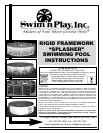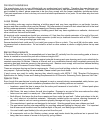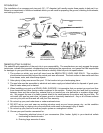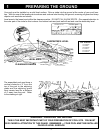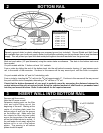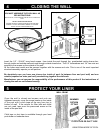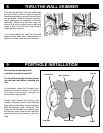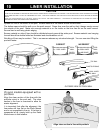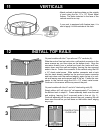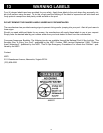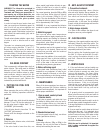
1
Contract Installations
The manufacturer is in no way affiliated with any professional pool installer. Therefore the manufacturer can
assume no responsibility, for errors in installation by the home owner or said professional installer. If you have your
pool installed by others, please supervise to be sure they comply with the proper installation techniques shown.
Their past experience or short cuts may not cover the latest improvements in our pools. Do not allow any short cuts
of any nature.
Local Codes
Local building code may require obtaining a building permit and may have regulations on set backs, barriers,
devices and other conditions that must be followed. Any after market or home built deck should be built to the local
building code requirements, including load capacity and fencing requirements.
Local electrical code may require obtaining a building permit and may have regulations on setbacks, devices and
other conditions that must be followed.
All electrical outlet connections should be a minimum of 5 feet from the outside perimeter of the wall of the pool.
From 5-10 feet there should be either a fixed connection (outlet box) or twistlock connection with a GFCI. Connect
power cords to a 3-wire grounding-type outlet only.
Severe electrical shock could result if you install your pump or filter on a deck. They could fall into the water, caus-
ing severe shock or electrocution. Do not install on a deck or other surface at, above or slightly below the top seat
of the pool.
Barrier Requirements
If the distance from the top of the assembled pool is less than 48" vertically from the surrounding grade, a fence or
barrier is needed to surround the pool with a minimum height of 48".
A barrier is necessary to provide protection against potential drowning and near drowning and is not a substitute for
constant supervision of children. A barrier is a fence, wall, or a combination thereof which completely surrounds the
swimming pool and obstructs access to the swimming pool. Barriers must comply with local and national building
codes and the US Consumer Product Safety Commission.
These are minimum fencing and barrier requirements. Check your local building codes for other requirements they
may request. Optional fencing kits are available, Please contact your local dealer.
If pool covers are used for safety barriers they should comply with ASTM F 1346 "Standard Performance
Specification for Safety Covers and Labeling Requirements for All Covers for Swimming Pools, Spas and Hot Tubs."
Special Care
Even though this manufacturer’s pools are designed to meet or exceed industry recommended safety factors, spe-
cial attention must be paid to some installation procedures that the installer performs and controls.
• Levelness- spend the time to assure that the entire pool framework is level within 1”. Unlevel pools place
extreme pressures on the pool walls
• Wall Seam- this area is where the wall joins together. Damage to any part of this area reduces the safety
factors and can result in a weak pool. Use extreme care following instructions.
• Earth Mound- this keeps the liner from creeping out from under the pool wall. Follow instructions to the let-
ter - don’t short-cut or substitute materials. Improperly installed pools can rupture, allowing thousands of
gallons of water to rush out causing extensive property damage and injury to anyone in its path.
• This manufacturer’s pools are not designed to be buried. Outside ground forces can collapse pool wall.
• The pool owner has the sole responsibility for providing adequate lighting for the pool area. It is important
that all users must be able to see the shallow depth of the pool, and safety signs at all times.
• You must install a pool ladder(s) for entry and exit from the pool
• All components such as the filtration system, pumps and heater should be positioned as to prevent their
being used as a means of access to the pool by young children



